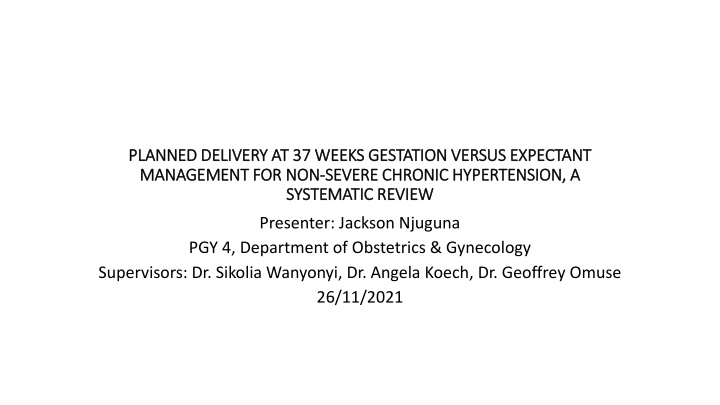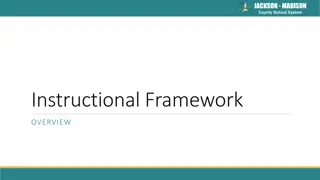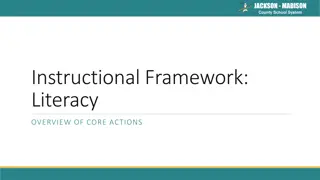
Delivery at 37 Weeks Gestation for Chronic Hypertension
This systematic review examines the benefits and risks of planned delivery at 37 weeks gestation versus expectant management for non-severe chronic hypertension in pregnant women. The study aims to assess outcomes such as maternal complications and perinatal risks associated with the timing of delivery.
Download Presentation

Please find below an Image/Link to download the presentation.
The content on the website is provided AS IS for your information and personal use only. It may not be sold, licensed, or shared on other websites without obtaining consent from the author. If you encounter any issues during the download, it is possible that the publisher has removed the file from their server.
You are allowed to download the files provided on this website for personal or commercial use, subject to the condition that they are used lawfully. All files are the property of their respective owners.
The content on the website is provided AS IS for your information and personal use only. It may not be sold, licensed, or shared on other websites without obtaining consent from the author.
E N D
Presentation Transcript
PLANNED DELIVERY AT 37 WEEKS GESTATION VERSUS EXPECTANT PLANNED DELIVERY AT 37 WEEKS GESTATION VERSUS EXPECTANT MANAGEMENT FOR NON MANAGEMENT FOR NON- -SEVERE CHRONIC HYPERTENSION, A SEVERE CHRONIC HYPERTENSION, A SYSTEMATIC REVIEW SYSTEMATIC REVIEW Presenter: Jackson Njuguna PGY 4, Department of Obstetrics & Gynecology Supervisors: Dr. Sikolia Wanyonyi, Dr. Angela Koech, Dr. Geoffrey Omuse 26/11/2021
Background and Objective Incidence of chronic of hypertension in pregnancy increasing (rising rates of obesity and delayed age at conception). Chronic hypertensive disease is independently associated with an increased incidence of adverse maternal and perinatal outcomes. Optimal timing of delivery for women with this condition has not been adequately addressed by available literature. We aimed to assess the benefits and risks of a policy of planned delivery versus expectant management in pregnant women with non- severe chronic hypertension at 37 weeks gestation.
Research Design & Outcomes A systematic review and a narrative synthesis as we did not find enough studies for a meta-analysis. Study types eligible - RCTS & cohort studies comparing the two policies. Participants - women with non-severe chronic hypertension from 37+0 to 42+0 weeks of gestation. Non-severe chronic hypertension- BP >140/90mmHg, < 160/110mmHg at recruitment or prior to 20 weeks gestation. The intervention we studied was timing of delivery.
Outcomes Primary outcomes Composite maternal outcome (including pre-eclampsia, placental abruption, admission to ICU) Composite perinatal outcome (including stillbirth, NICU admission) Secondary outcomes Maternal-pre-eclampsia, placental abruption and admission to ICU. Perinatal-stillbirth and admission to NICU)
Intervention Experimental intervention group - delivery at 37 completed weeks. Oxytocin infusion and amniotomy or cervical ripening based on Bishop score. Comparator intervention group- expectant management until the spontaneous onset of labour or 41 gestational weeks. Inpatient monitoring.
Overall Completeness of the Evidence The search strategy was broad and inclusive and no date or language restrictions were applied in the primary search. One RCT deemed eligible for the final review. Reference list of the included study was searched. None of the referenced studies was eligible for inclusion. The review protocol was registered with PROSPERO prior to starting the formal screening of articles based on eligibility criteria. The review conducted based on the steps outlined in the protocol. Meta-analysis not done due to limitation by number of studies. Instead, narrative synthesis was done as earlier pre-specified.
Potential Bias in Review Process The assessment of risk of bias involves subjective judgements. This potential limitation was minimized by following the procedures in the Cochrane Handbook for Systematic Reviews of Interventions . Measurement of the level of agreement using the kappa statistic at the initial screening of articles and at the level of full text review indicated an acceptable level of agreement for systematic review. Our search was limited to three major electronic bibliographic databases. We did not search for unpublished trials or gray literature and no correspondence was made to experts in the area of study.
Implications for Practice In the setting of non-severe chronic hypertension in pregnancy, the evidence shows that expectant management up to 41 weeks gestation could be chosen over planned delivery at 37 weeks gestation as this was associated with significantly lower rates of admission to NICU. There is no significant difference in rates of developing super- imposed pre-eclampsia, placental abruption or perinatal mortality.
Implications for research The question on optimal timing of delivery for women with non-severe chronic hypertension at term is critical but not adequately addressed by currently available literature. There is need for high quality studies that are sufficiently powered to address the review question taking into consideration the need for allocation concealment, blinding of outcome assessors and clearly outlined methods of assessing the outcomes of interest. These studies should also include other outcomes like maternal admission to ICU. RCTs that include participants in different settings will improve the generalizability of the findings. This will enable combining of data from different studies to assess pooled effects in a meta-analysis. Consequently, this will enable recommendations to be made with a higher level of certainty.





















